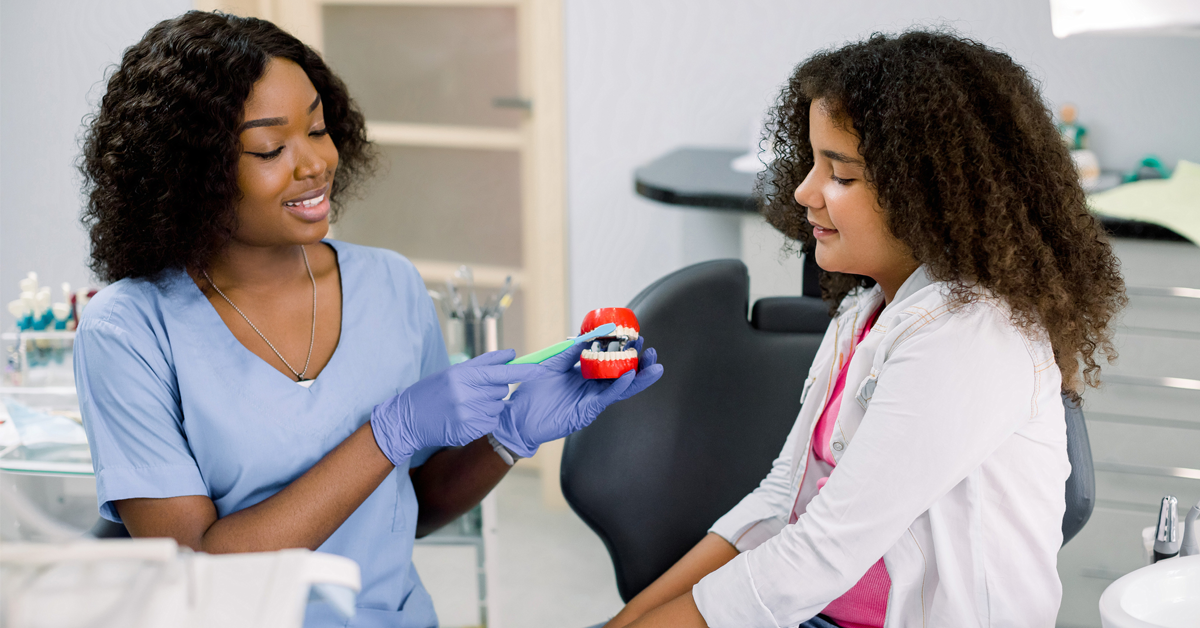For years, oral health advocates such as yourselves, the American Dental Association (ADA) and other organizations have made a concerted effort to educate children and their parents about the importance of oral health self-care, such as brushing and flossing properly every day. The United States government has also done a lot of work in this area, including making child dental care a priority for insurance programs at the federal and state level.
These combined efforts have borne fruit, as there has been a drop in the level of pediatric tooth decay in the United States over the past several decades.
But these positive steps don’t mean tooth decay or other oral health issues are no longer concerns for children. Just as it is for infants, teens, adults, and seniors, adequate dental care is incredibly important for children between the ages of 6-12. That means dental teams share a role in helping to build oral health habits.
But by working in tandem with parents and guardians, you can help ensure your youngest patients will have healthy smiles for years to come. In this article, we’ll help you guide the conversation with some helpful talking points.
Talking point #1: Why children’s oral health is so important
Between ages 6-12, children generally lose all of their primary teeth, better known as “baby teeth.” These are slowly replaced with their adult (permanent) teeth. Here’s how it typically goes:
- The incisors, or “front teeth,” will likely come first on the top and bottom at around ages 6-7
- Then come the six-year molars
- The lateral incisors are next
- Then, the rest of the teeth follow, filling in further back in the jaw.
- By age 13, after the 12-year molars grow in, your child will be sporting a mouthful of permanent teeth.
As adult molars start coming in, how they develop will have an impact on the shape of the jaw, the child’s bite, and other factors that could affect them in the future.
It’s also possible for a slowly loosening primary tooth to hide tooth decay in a newly erupting permanent tooth. This phenomenon can also cause adult teeth to come in misaligned. How quickly a baby tooth loosens and comes out is based on several factors, so every child is different.
Finally, the periods during which baby teeth are loose can impact oral hygiene. It creates gaps beneath which food particles can get lodged. At the same time, the area may be tender, making the child more likely to skip brushing and flossing or do a superficial job.
Because a child’s teeth are going through so many changes during this time, it is important to make sure your children visit the dentist regularly to monitor the development of their adult teeth.
Talking point #2: Dental hygiene is a learned habit
It is generally recommended that children brush and floss after every meal or three times per day. Of course, every kid has far too many important games to play and places to explore to think about that consistently on their own. That’s why adults will likely need to help their kids brush and floss until they are a little older. But parents and guardians need to ensure they are actively following oral health habits themselves before stepping in to help and offer guidance.
It may help to use child-size flossers with handles to teach proper flossing techniques and a toothbrush that’s designed specifically for kids. Then, after they’re done, adults can take a final look to ensure the child’s teeth are adequately clean.
Following this pattern, parents and guardians can make sure their children are taking good care of their teeth and getting important practice for maintaining good oral health habits as they grow.
Talking point #3: Don’t lose patience when kids decide to be kids
Any parent will tell you that it’s common for kids at this age to start asserting their independence, even though they are clearly not ready to start making all their own decisions. As a result, children may rebel against brushing their teeth and not want to stop the fun or exciting thing they are doing to practice those good habits they’ve been practicing.
This can be challenging, but it’s important for adults to make sure their children are still brushing and flossing thoroughly. We promise it will get easier with time.
Talking point #4: Beware the sweet tooth and get creative with healthy snacking
Speaking of kids being kids, children often have an insatiable sweet tooth at this age. We all know you can prevent cavities by reducing the consumption of candy, fruit juices, soda and other sugary drinks and snacks. But even if this message is taught at home, children and preteens aren’t exactly known for their self-discipline when a sugary treat is calling their name.
To help curb a sweet tooth, try these five tips to keep kids’ mouths healthy while getting their snack fixes satisfied. If kids do indulge in sweets sometimes, it isn’t the end of the world. But be sure they’re brushing their teeth and drinking plenty of water to rinse and prevent dry mouth. If your child chews gum, try to get the sugar-free varieties to prevent cavities.
Note: Be especially mindful of your child’s dietary preferences around the time the six-year molars are coming in. They’ll likely prefer softer foods or experience appetite shifts due to tenderness. You can accommodate your child with soft fruits, smoothies, soups and steamed veggies.
Talking point #5: Make the dentist appointment something to look forward to
Perhaps the most important thing parents and guardians can do to prioritize their child’s dental care is to make sure they’re visiting the dentist at least twice every year for a routine examination and professional cleaning.
We know you and your team are awesome, but sadly, going to the dentist isn’t always the highlight of a child’s week. But by working in tandem with parents and guardians, you can help create a positive outlook for the experience that will help foster a child’s attitude toward seeking dental care for years to come. To help reinforce the positive vibes, have some arrangements in place to make the experience as fun, engaging and comfortable as possible. For instance, you can add a child-friendly section to the waiting room or give away some fun prizes in a takeaway bag.
The bottom line: A kid’s oral health journey is not taken alone. When dental teams work together with parents and guardians, they are building the foundation for instilling life-long dental hygiene habits.

